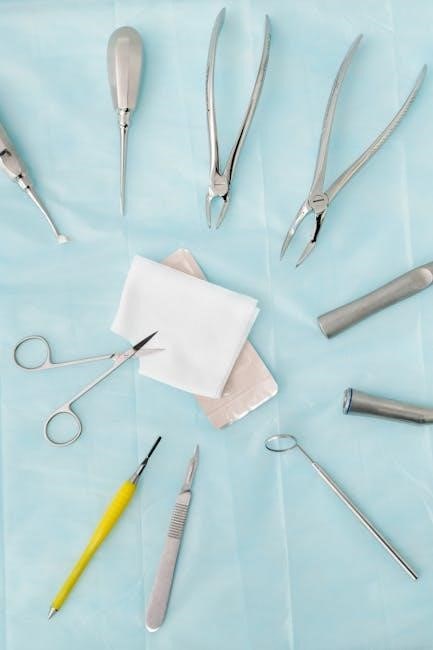Post-surgical instructions are crucial for proper healing and minimizing complications. They guide patients through recovery, ensuring safety and optimal outcomes after their operation, covering wound care, pain management, and activity levels.
1.1 Importance of Following Post-Surgical Care
Following post-surgical care is essential for preventing infections, managing pain, and ensuring proper wound healing. It helps minimize complications, reduces recovery time, and promotes overall well-being. Adherence to these guidelines can significantly improve surgical outcomes and reduce the risk of postoperative issues, playing a critical role in the recovery process.
1.2 Common Goals of Post-Surgical Recovery
Common goals of post-surgical recovery include preventing infection, managing pain, and promoting wound healing. Additionally, restoring physical function, minimizing complications, and ensuring a smooth transition to normal activities are key objectives. Achieving these goals helps patients regain their health and well-being while reducing the risk of long-term issues.

Immediate Post-Surgical Care
Immediate post-surgical care focuses on monitoring for complications, managing pain, and maintaining wound hygiene. Patients should rest, avoid strenuous activities, and follow specific instructions to ensure a safe recovery period.
2.1 Managing Pain and Discomfort
Managing pain and discomfort after surgery is essential for recovery. Patients should follow prescribed painkiller regimens, rest adequately, and apply ice if recommended. Over-the-counter medications may also be used under medical guidance to alleviate discomfort without delaying healing or causing complications.
2.2 Wound Care and Dressing
Proper wound care is vital for healing and preventing infection. Keep the area clean and dry, using prescribed cleaning solutions. Change dressings as directed and monitor for signs of infection, such as redness or swelling. Surgical drains may be used to remove fluid, promoting a clean environment for recovery.
2.3 Activity Level and Rest Recommendations
Rest is crucial after surgery to promote healing. Avoid strenuous activities and follow your doctor’s guidance on safe movements. Gradually increase activity levels, starting with short walks, to prevent overexertion. Listen to your body and prioritize recovery to ensure a smooth and safe return to normal activities.

Dietary Considerations After Surgery
A balanced diet rich in nutrients, fruits, and vegetables supports recovery. Avoid heavy meals and opt for light, easily digestible foods to aid healing and reduce discomfort.
3.1 Recommended Foods for Recovery
Nutrient-rich foods like lean proteins, whole grains, and vibrant vegetables promote healing. Incorporate foods high in vitamin C, zinc, and fiber to boost immunity and tissue repair. Opt for soft, easily digestible meals and stay hydrated with clear broths or herbal teas to support recovery and minimize discomfort.
3.2 Foods to Avoid During Healing
Avoid heavy, fatty, or spicy foods that can irritate the digestive system. Limit sugary and processed foods, as they may slow healing. Caffeine and alcohol should be minimized to prevent dehydration and medication interactions. Opt for bland, nutrient-rich options to support recovery and reduce discomfort.
3.3 Hydration Tips
- Drink plenty of water daily to aid healing and prevent dehydration.
- Avoid alcohol, as it can interfere with recovery and medications.
- Opt for clear fluids like broth or herbal teas to stay hydrated.
- Include water-rich foods, such as fruits and vegetables, in your diet.
- Limit caffeine intake to avoid fluid loss and discomfort.

Managing Medications
Adhering to your prescribed medication regimen is vital for recovery. Always consult your healthcare provider before taking any medications, including over-the-counter drugs, to avoid adverse interactions and ensure proper healing.
4.1 Prescription Painkillers and Usage
Prescription painkillers are often necessary to manage post-surgical discomfort. Always follow the dosage instructions provided by your healthcare provider to avoid overuse or dependence. Take medications as directed, with food if recommended, and monitor for side effects. Never mix painkillers with other medications without consulting your doctor to ensure safety.
4.2 Over-the-Counter Medications
Over-the-counter medications, like ibuprofen or acetaminophen, can help manage mild to moderate post-surgical pain. Always follow the recommended dosage and consult your doctor before use, especially if taking other medications. These drugs can aid recovery but should be used cautiously to avoid side effects or interactions with prescribed treatments.
4.3 Avoiding Certain Medications
Certain medications, such as blood thinners or NSAIDs, should be avoided after surgery to prevent complications. Always consult your doctor before taking any medication, including over-the-counter drugs, to ensure they won’t interfere with healing or interact negatively with prescribed treatments. This precaution is critical for a safe recovery.

Emotional and Mental Health Support
Emotional well-being is crucial after surgery. Patients may experience anxiety or depression. Managing stress, seeking support from loved ones, and considering professional counseling can aid in a smoother recovery.
5.1 Coping with Anxiety or Depression
Coping with anxiety or depression after surgery is essential for recovery. Patients often feel overwhelmed, but seeking support from loved ones and professionals can help. Stress management techniques and monitoring symptoms are crucial steps toward emotional healing and overall well-being.
5.2 Building a Support Network
Building a support network is vital for post-surgical recovery. Involving family, friends, and support groups can provide emotional and practical assistance. Clear communication about your needs helps loved ones contribute effectively, fostering a sense of security and reducing feelings of isolation during the healing process.
5.3 Professional Counseling Options
Professional counseling offers tailored support for emotional and mental challenges post-surgery. Therapists provide coping strategies for anxiety or depression, helping patients adjust to lifestyle changes. Counseling services can be in-person or virtual, ensuring accessibility and personalized care during recovery.

Follow-Up Care and Appointments
Follow-up care and appointments are essential for monitoring recovery progress. Regular check-ups help identify potential complications early, ensuring proper healing and a smooth transition back to normal activities.
6.1 Scheduling Postoperative Visits
Scheduling postoperative visits is vital for monitoring recovery progress. Patients should follow their surgeon’s recommended timeline for follow-ups. Online resources, like Google, can provide tips on how to find and schedule these appointments. Regular check-ups help ensure proper healing, address concerns, and prevent complications. Preparing a list of questions beforehand ensures all concerns are addressed during visits.
6.2 What to Expect During Follow-Up
During follow-up visits, expect your healthcare provider to monitor healing progress, check for infection signs, and examine the surgical site. They may also discuss pain management, review medication use, and provide guidance on returning to daily activities. Emotional support and addressing concerns are also key parts of these appointments.
6.3 Importance of Attending All Appointments
Attending all follow-up appointments ensures proper healing, allows early detection of complications, and confirms the surgery’s success. Missed appointments can delay recovery, lead to unresolved issues, or result in further complications. Regular check-ups are vital for a smooth and safe return to normal activities after surgery.

Preventing Infections
Preventing infections after surgery is crucial for a safe recovery. Proper wound care, hygiene, and following medical advice significantly reduce infection risks and promote healing.
7.1 Signs of Infection to Watch For
Monitor for redness, swelling, warmth, or pus around the surgical site. Fever, chills, or a foul odor from the wound may indicate infection. Notify your healthcare provider immediately if these symptoms appear, as early detection is key to effective treatment and preventing complications.
7.2 Proper Hygiene Practices
Wash hands thoroughly with soap and water before touching the surgical site. Use antibacterial soap to clean the area gently, pat dry with a clean towel, and avoid submerging the wound in water. Keep the surrounding environment clean and follow specific hygiene instructions provided by your healthcare provider to reduce infection risks.
7.3 Antibiotic Use and Resistance
Antibiotics are often prescribed after surgery to prevent infection. Use them as directed to avoid resistance. Overuse or incorrect dosing can lead to antibiotic resistance, reducing their effectiveness. Always follow your healthcare provider’s instructions to ensure proper healing and minimize resistance risks.

Physical Activity and Mobility
Physical activity and mobility are crucial for recovery, balancing rest with gentle movement to prevent complications and promote healing. Follow guidelines to avoid overexertion and ensure safe progress.
8.1 Safe Exercises for Recovery
Gentle exercises like deep breathing, short walks, and light stretching are essential for recovery. They improve circulation, reduce stiffness, and promote healing without overexertion. Always consult your healthcare provider to tailor exercises to your specific surgical needs and ensure safety.
8.2 Avoiding Overexertion
Avoiding overexertion is key to prevent complications and promote healing. Rest and listen to your body, as overexertion can lead to pain, swelling, or prolonged recovery. Stick to recommended activity levels and avoid heavy lifting or strenuous exercises until cleared by your surgeon. Monitor for signs of overexertion, such as increased pain or fatigue.
8.3 Benefits of Early Mobilization
Early mobilization after surgery reduces the risk of complications, improves circulation, and enhances recovery. It helps prevent blood clots, strengthens muscles, and boosts mental health by reducing lethargy. Patients should follow specific exercises and schedules as recommended by their healthcare providers to ensure safe and effective progress.
Lifestyle Adjustments
Adopting healthy habits, such as quitting smoking, limiting alcohol, and managing stress, supports recovery and overall well-being after surgery. These changes promote healing and reduce risks of complications.
9.1 Smoking Cessation
Smoking cessation is vital after surgery as it improves healing, reduces infection risks, and promotes faster recovery. Smoking impairs oxygen flow and weakens the immune system, delaying wound healing. Quitting helps minimize complications and enhances overall surgical outcomes. Consider nicotine replacement or counseling for support.
9.2 Limiting Alcohol Consumption
Limiting alcohol after surgery is crucial for proper healing and reducing risks. Alcohol can impair the body’s ability to recover, interact with medications, and increase infection chances. Avoiding alcohol helps maintain liver function and supports overall recovery. Patients should follow specific guidelines provided by their healthcare provider.
9.3 Stress Management Techniques
Stress management is vital for recovery, as high stress levels can slow healing. Techniques like deep breathing, meditation, and mindfulness can help reduce stress. Seeking support from family, friends, or counselors is also beneficial. Engaging in light physical activity and maintaining a structured routine can further promote emotional well-being and recovery.

Common Post-Surgical Complications
Common post-surgical complications include infections, blood clots, and respiratory issues. Recognizing these early is key to effective management and ensuring a smooth recovery process for patients.
10.1 Recognizing Complications Early
Recognizing post-surgical complications early is vital for effective treatment. Monitor for signs like redness, swelling, fever, or shortness of breath. Unusual pain or chest pain may indicate blood clots or respiratory issues. Prompt medical attention can prevent severe outcomes and improve recovery chances significantly.
10.2 Blood Clots and Deep Vein Thrombosis
Blood clots and deep vein thrombosis (DVT) are serious post-surgical risks. Symptoms include leg swelling, pain, or discoloration; Early detection is critical, as untreated clots can lead to pulmonary embolisms. Preventive measures like compression devices or medications are often prescribed to reduce this risk during recovery.
10.3 Respiratory Issues
Respiratory complications, such as pneumonia or atelectasis, can occur post-surgery. Shallow breathing due to pain or anesthesia increases these risks. Early mobilization and deep breathing exercises are essential to prevent such issues. Patients should seek immediate medical attention if they experience shortness of breath, chest pain, or persistent cough.

Long-Term Recovery and Rehabilitation
Long-term recovery and rehabilitation are gradual, varying by individual. Physical therapy restores strength and mobility, focusing on safely returning to normal activities and daily routines.
11.1 Timeline for Full Recovery
Full recovery timelines vary based on surgery type and individual health. Most patients see significant progress within 8-12 weeks, but complete healing may take up to 6-12 months. Factors like overall health and adherence to post-surgical care influence recovery speed and outcomes.
11.2 Role of Physical Therapy
Physical therapy plays a vital role in post-surgical recovery by restoring strength, mobility, and function. It helps prevent complications, promotes healing, and accelerates return to normal activities. Tailored exercises improve flexibility and reduce discomfort, ensuring a safer and more effective recovery process for patients.
11.3 Returning to Normal Activities
Returning to normal activities after surgery requires patience and gradual resumption. Listen to your body, avoid overexertion, and follow healthcare provider guidance. Set realistic goals, incorporate light exercises, and prioritize rest to ensure a smooth transition back to daily routines and hobbies without compromising recovery progress or overall well-being.
Adhering to post-surgical instructions ensures a smooth recovery, minimizing complications, and promoting healing. Proper care, rest, and patience are key to resuming normal activities and achieving long-term well-being.
12.1 Summary of Key Recovery Practices
Following post-surgical instructions ensures safety and optimal healing. Key practices include proper wound care, managing pain, adhering to medication schedules, resting adequately, and maintaining hydration. Avoiding overexertion and adhering to dietary advice helps prevent complications. Emotional support and follow-up appointments are also crucial for a successful recovery journey and overall well-being after surgery.
12.2 Final Tips for a Smooth Recovery
Stay informed, follow guidelines, and monitor your health closely. Maintain proper hygiene, adhere to medication schedules, and seek support when needed. Prioritize rest, hydration, and balanced nutrition to aid healing. Keep all follow-up appointments and communicate openly with your healthcare team to ensure a seamless and effective recovery process after surgery.